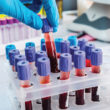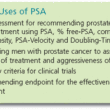The Prostate Cancer Active Surveillance Project
Dr. Catalona is part of a collaborative research team building a large, multi-institutional study to determine the best ways to manage men diagnosed with favorable-risk prostate cancer. The Prostate Cancer Active Surveillance Project (PCASP) aims to develop a new gold standard of active surveillance guidelines and practices. The new project will expand on Dr. Catalona’s ongoing research project on germline genetics in patients on active surveillance.

Active surveillance is important for reducing overtreatment of men with favorable-risk prostate cancer. However, there is a substantial need to improve the appropriate implementation of active surveillance.
The most critical question with active surveillance is: “Which patients can be safely treated with active surveillance?” Currently, numerous national professional organizations have issued varied guidelines on active surveillance that are based on expert opinion, but not necessarily on published scientific evidence. There is a lack of cohesion that leads to confusion among physicians and patients. There are controversies regarding whether active surveillance is appropriate for men of African ancestry or for younger men, or for men whose biopsies reveal certain features, such as Gleason pattern 4, or for men with a genetic predisposition for aggressive cancer.
In addition, while recent estimates suggest that the use of active surveillance for low-risk prostate cancer is on the rise-some reports suggest that 40-50% of U.S. men elect active surveillance-there is striking variation among individual urology practices and care providers. It may be that a patient’s management is influenced more by the doctor he sees than by the features of his disease. Many experts in the urology community believe that active surveillance could be more effectively used, such as in Sweden, where the active surveillance treatment rate is approximately 80%.
However, data continues to demonstrate that a significant number of men stop, or “fail,” active surveillance due to disease progression or patient anxiety. Approximately half of men on active surveillance convert to other treatments within five years. Using the biomarkers currently in practice, it is not possible to accurately discriminate between indolent and aggressive cancers, and thus identify which patients harbor undetected aggressive prostate cancer who may suffer from delaying treatment. In addition, biopsy sampling errors can miss more aggressive cancers that progress to metastatic disease while the patient delays active treatment. Overall, 30-40% of active surveillance patients are later found to have more aggressive disease.
Addressing the problems with research
The goal of the new research initiative, the Prostate Cancer Active Surveillance Project (PCASP), is to determine the best management approach for individual patients diagnosed with low-risk prostate cancer. The team proposes to use their partnership with two large, national community-based patient registries to launch the largest integrated, multidisciplinary effort to date in active surveillance research. The team seeks to establish scientifically-backed active surveillance guidelines and a clinical pathway that could be easily incorporated into existing medical technology, which will ultimately allow for greater personalization and improved outcomes for prostate cancer patients across the country. To accomplish this, the PCASP has proposed three research projects.
Improving care with medical technology
The goal of Project 1 is to address the overtreatment and under-treatment of men with prostate cancer and give physicians access to tools that improve personalized medicine. The project’s clinical trials will seamlessly integrate newly developed “physician dashboards” into electronic medical records software already in use in clinics. This physician dashboards are assessment tools that will help physicians and patients determine if active surveillance is appropriate based on each patient’s data and preferences. The data will include disease characteristics such as Gleason score, prostate volume, genetic and genomic test results, as well as a patient’s life expectancy. The study seeks to determine whether these physician dashboards improve patient care by encouraging doctors to more accurately select patients for active surveillance or active treatment.
Searching for genetic variants for prostate cancer
Dr. Catalona is a leader on Project 2, which continues the work of identifying genetic variants that impact prostate cancer aggressiveness. Dr. Catalona’s current SPORE project, entitled The Impact of genetic variants on failure of active surveillance for prostate cancer, is the largest genetic association study to date of men on active surveillance, with more than 6,400 men participating.* The goal of the SPORE project is to identify germline genetic variants that are associated with patients who fail active surveillance. Project 2 in the PCASP will incorporate the SPORE project findings while also assessing genetic variants among approximately 10,000 prostate cancer patients on active surveillance. Genetic studies require large study populations to ensure the results are statistically significant. This project will also benefit from the PCASP’s partnership with private urology practices, which will enable more men to participate in the study.
Analyzing the cost of care
Project 3 is a cost effectiveness study. When compared to patients who elect immediate treatment or patients who remain on active surveillance, patients who fail active surveillance are the most expensive option for the health care system. These patients undergo surveillance testing including biopsies, MRIs, and other tests, and then subsequently also require treatment. This project will use statistical modeling and data analysis to determine if more accurate selection of patients for active surveillance will reduce costs for the health care system.
An integrated team
In addition to the research teams, the PCASP also includes three cores that support administration and leadership, electronic medical record data extraction and analysis, biostatistics and biospecimens, as well as a dissemination core that will help the project publicize their results across the medical and lay communities.
Altogether, the PCASP has great potential to impact the treatment strategy for patients with low-risk prostate cancer across the country. The team’s grant application is currently under review at the National Cancer Institute.
*The Urological Research Foundation provides additional funding for Dr. Catalona’s SPORE research project.





















